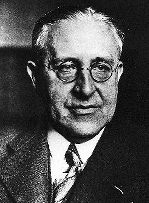Hess's Law Germain Henri Hess (1802 - 1850) is important primarily for his thermochemical studies. Hess' Law states that the heat evolved or absorbed in a chemical process is the same whether the process takes place in one or in several steps. This is also known as the law of constant heat summation. Hess's law can be applied to calculate enthalpies of reactions that are difficult to measure. In the above example, it is very difficult to control the oxidation of graphite to give pure CO. However, enthalpy for the oxidation of graphite to CO2 can easily be measured. So can the enthalpy of oxidation of CO to CO2. The application of Hess's law enables us to estimate the enthalpy of formation of CO.  This is Germain Henry Hess
This is Germain Henry Hess